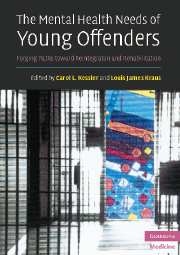Book contents
- Frontmatter
- Contents
- List of contributors
- Foreword
- Acknowledgments
- 1 An overview of child and adolescent mental health needs in the juvenile justice system
- 2 Psychiatric disorders of youth in detention
- 3 Disproportionate minority confinement
- 4 Police interrogation of youth
- 5 Assessing children's competence to stand trial and to waive Miranda rights: new directions for legal and medical decision-making in juvenile courts
- 6 The etiology of antisocial behavior: biopsychosocial risk factors across development
- 7 Substance abuse in youth offenders
- 8 Suicide and delinquent adolescents
- 9 Juvenile sex offenders
- 10 Educational needs of youth in the juvenile justice system
- 11 Science and the juvenile death penalty
- 12 Medical issues regarding incarcerated adolescents
- 13 Mental health screening and assessment in juvenile justice
- 14 Psychological testing in juvenile justice settings
- 15 Psychopharmacology and juvenile delinquency
- 16 Evidence-based treatment for justice-involved youth
- 17 Community alternatives to incarceration
- 18 Innovative problem-solving court models for justice-involved youth
- 19 Ethical issues of youthful offenders: confidentiality; right to receive and to refuse treatment; seclusion and restraint
- 20 Post-adjudicatory assessment of youth
- Index
- References
3 - Disproportionate minority confinement
Published online by Cambridge University Press: 11 August 2009
- Frontmatter
- Contents
- List of contributors
- Foreword
- Acknowledgments
- 1 An overview of child and adolescent mental health needs in the juvenile justice system
- 2 Psychiatric disorders of youth in detention
- 3 Disproportionate minority confinement
- 4 Police interrogation of youth
- 5 Assessing children's competence to stand trial and to waive Miranda rights: new directions for legal and medical decision-making in juvenile courts
- 6 The etiology of antisocial behavior: biopsychosocial risk factors across development
- 7 Substance abuse in youth offenders
- 8 Suicide and delinquent adolescents
- 9 Juvenile sex offenders
- 10 Educational needs of youth in the juvenile justice system
- 11 Science and the juvenile death penalty
- 12 Medical issues regarding incarcerated adolescents
- 13 Mental health screening and assessment in juvenile justice
- 14 Psychological testing in juvenile justice settings
- 15 Psychopharmacology and juvenile delinquency
- 16 Evidence-based treatment for justice-involved youth
- 17 Community alternatives to incarceration
- 18 Innovative problem-solving court models for justice-involved youth
- 19 Ethical issues of youthful offenders: confidentiality; right to receive and to refuse treatment; seclusion and restraint
- 20 Post-adjudicatory assessment of youth
- Index
- References
Summary
Disproportionate minority confinement generally refers to the disproportionate percentage of minority youth or one group of youth confined in juvenile detention facilities relative to the percentage of youth found in the local or surrounding jurisdiction. The term, disproportionate minority confinement (DMC), has been the preferred term in the juvenile justice system since the late 1980s. When the reauthorization of the Juvenile Justice Delinquency and Prevention (JJDP) Act (2002) was passed, the Act mandated states to address: “juvenile delinquency prevention efforts and system improvement efforts designed to reduce, without establishing or requiring numerical standards or quotas, the disproportionate number of juvenile members of minority groups who come into contact with the juvenile justice system.” This is different from the previous act in that the requirement is broadened from “confinement” to “contact” by requiring states to examine possible disproportionate representation of minority youth at all decision points along the juvenile justice system continuum.
Other terms used to refer to this pattern of practice include “overrepresentation,” “disparity,” and “discrimination.” Overrepresentation exists when, at various stages of the juvenile justice system, the proportion of a certain population exceeds its proportion in the general population. Disparity refers to a situation in which different groups have different probabilities that certain outcomes will occur. Disparity may in turn lead to overrepresentation. Discrimination refers to differential decision-making among juvenile justice professionals affecting different groups of juveniles based on their gender, racial, and/or ethnic identity.
Keywords
- Type
- Chapter
- Information
- The Mental Health Needs of Young OffendersForging Paths toward Reintegration and Rehabilitation, pp. 48 - 60Publisher: Cambridge University PressPrint publication year: 2007
References
- 1
- Cited by



